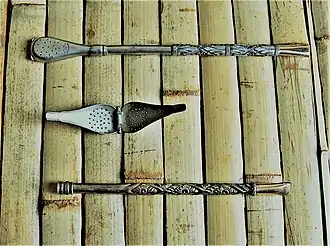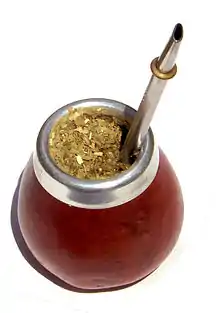Bombilla
A bombilla (Spanish), bomba (Portuguese) or massasa (Arabic) is a type of drinking straw, used to drink mate.[1] In metal bombillas, the lower end is perforated and acts as a metal filter which is used to separate the mate infusion from leaves, stems, and other mate debris, and functions in a similar fashion to the perforated metal screen of a teapot.[2] Filters can be removable and can be opened for cleaning, or they may be permanently fixed to the bombilla stem. Bombillas vary in length but a popular length is approximately 7 inches (18 cm) long.[3]

Traditional bombillas are made of metal alloys such as an alloy of copper and nickel called alpaca silver or German silver, stainless steel, and 800 silver which is used to construct the filter and stem, sometimes combined with a gold plated head. Low-end bombillas are made from hollow-stemmed cane. Silver bombillas are popular.[4] In recent times, the traditional silver bombillas are being replaced by ones made from stainless steel.[5]
Silver bombillas were used by the privileged classes, while those made of straw were used by people of lesser means.[2] Due to the high thermal conductivity of silver, bombillas and gourds made of silver can get very hot fast, requiring caution when drinking hot mate tea to avoid burns.[4][6]
Etymology
The Spanish name "Bombilla" means literally "little pump".[2][7][8] The Spanish term is also used for electric lightbulbs, bombilla eléctrica, being a diminutive of bomba.[1]
Gallery
 Different types of bombillas, with a common matchstick for scale
Different types of bombillas, with a common matchstick for scale José Gaspar Rodríguez de Francia, a 19th-century consul and dictator of Paraguay, with a mate gourd and its respective bombilla
José Gaspar Rodríguez de Francia, a 19th-century consul and dictator of Paraguay, with a mate gourd and its respective bombilla Silver Bombillas ca. 1840 at the Museo Histórico Cornelio de Saavedra, Buenos Aires, Argentina
Silver Bombillas ca. 1840 at the Museo Histórico Cornelio de Saavedra, Buenos Aires, Argentina Bombilla in a gourd with mate
Bombilla in a gourd with mate
References
- Diccionario de la lengua española. "Diccionario de la lengua española - Real Academia Española". Lema.rae.es. Retrieved 2013-12-16.
- The Edinburgh New Philosophical Journal: Exhibiting a View of the Progressive Discoveries and Improvements in the Sciences and the Arts. Adam and Charles Black. 1856. p. 194.
The mate is then filled with yerva, after the bombilla has been placed in position. The bombilla is literally " a little pump," that is, a sucking tube, ending in a perforated bulb, which performs the office of the perforated diaphragm in our teapot...
- Journal of the American Historical Society of Germans from Russia. American Historical Society of Germans from Russia. 1978. pp. 29, 46.
The straw, rorchen, or bombilla is about seven inches long, with a strainer on the lower end to ...
- Fiona Adams (1 July 2011). CultureShock! Argentina: A Survival Guide to Customs and Etiquette. Marshall Cavendish International Asia Pte Ltd. p. 133. ISBN 978-981-4346-77-1.
- Elisabeth Hsu; Stephen Harris (2010). Plants, Health and Healing: On the Interface of Ethnobotany and Medical Anthropology. Berghahn Books. p. 281. ISBN 978-1-84545-060-1.
- Jeannine J. Falino; Gerald W. R. Ward (2008). Silver of the Americas, 1600-2000: American Silver in the Museum of Fine Arts, Boston. MFA Pub. p. 488\QUOTE=As with mate cups made entirely of silver, the thermal conductivity of silver bombillas may have posed problems for the drinker. ISBN 978-0-87846-721-1.
- Pan American Union (1916). Yerba Mate: the Tea of South America ... U.S. Government Printing Office. p. 11.
This implement was given the name of bombilla — little pump — by the Spaniards, who later improved it by making it of ...
- Jeannine J. Falino; Gerald W. R. Ward (2008). Silver of the Americas, 1600-2000: American Silver in the Museum of Fine Arts, Boston. MFA Pub. pp. 482–488. ISBN 978-0-87846-721-1.
Translated as "little pump," a bombilla is a specialized straw having a pierced bulb at one end that is inserted in a mate cup (cat. nos. 384-88). The bulb, designed to strain out the yerba mate, is an ingenious element that is perhaps best ...